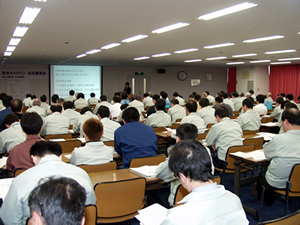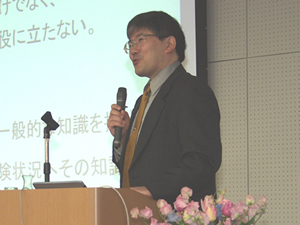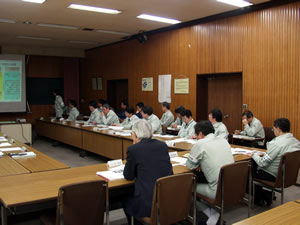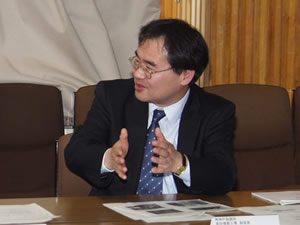|
|
 |
| The 79 th Safety Caravan was held at the Hitachi works of Hitachi, Ltd. in the city of Hitachi , Ibaraki Prefecture on February 10, 2006.
|
|
Safety Presentation |
Approximately 160 employees of Hitachi, Ltd. and affiliated companies attended the safety presentation.
At the start of the presentation, Akira Maru, Power Systems General Manager of the Hitachi Works of Hitachi , Ltd. delivered a salutation to the audience as follows. "Nuclear power is extremely high level and consists of multiple systems, and it is a job that numerous people take part in. What is important here is that while we learn from each other and share our knowledge, what is especially significant is that we must not repeat the same mistakes. From now on, as new developments unfold and nuclear power becomes the mainstay of energy in the world, we, Japanese manufacturers, must be active." |

|
|
Safety Presentation
|
After the words of greeting, the Manager of NS Net Division introduced the activity policy of the Japan Nuclear Technology Institute (JANTI) and the state of activities of the NS Net Division, followed by a presentation on "Incorporating the Knowledge of Failures into the System" by Professor Masayuki Nakao of the School of Engineering at the University of Tokyo. |

|
|
Dr.Masayuki Nakao
|
Lecture highlights
Some important points that Dr.Nakao brought up included the following.
○
Based on the lessons learned from experiences of failures, the causes can be classified into 41 categories, and all failures originate from these. With an understanding of these 41 categories, past mistakes shall not be in vain, but can be made practical use of.
○ Collecting examples of mistakes is quite simple. From these, it is important to extract the general knowledge of similarities and repeated mistakes and apply this knowledge to the dangers surrounding one's own current situation. However, since there are few actual examples with the very exact same circumstances, we must think in a higher level concept.
○ Even though useful knowledge and information can be obtained, one may be unaware of the points of similarity, and half of all people are unable to develop a particular solution from a general solution on their own. This is a serious problem. Effective ways of educating those who are unable to utilize a higher level concept are systematization that stencils into the brain the knowledge acquired, training in the establishment of problems (required functions) and crisis prediction training for technicians.
○ In order to avoid human error, it is important to set up a system of automatic failure avoidance. However, when unforeseen events occur, ultimately, what is needed and what determines safety and peace of mind is the person with an overall understanding of the situation.
○ The people who design the systems become more and more clever, but the people who only make use of these convenient systems have a tendency to use their brains less and less. It is possible to enable a system to prevent failures, but the big problem is these two extremes of types of people.
|
The following comments were given in the questionnaire distributed after the presentation.
-Shortly after being employed by my company, I remember being taught by my senior workers to ask the essential "why?" question. Having listened and paid close attention to today's presentation, I felt the necessity of getting this message across to my juniors was increasingly critical. In any case, I think the crucial issue is to get into the habit of thinking using one's own brain.
- We have been given hints as to how we should be thinking about things, but how to reflect today's presentation in actual concrete schemes is no simple matter. It seems that individual performance will not go according to the expectations of the management.
-In compiling the database, it is useful to understand the importance of finding general solutions. We want to endeavor to convey this to everyone in easy to understand terms.
|
Safety information exchange session |
 |
|
Safety information exchange session |

|
|
Mr.Masayuki Nodaka
|
(1)Introduction of endeavors and exchanges of opinions
At the Safety Information Exchange Session, the Manager of the Manufacturing Section of Takasogo Equipment Plamt , Machinery and Engineering Company of Kobe Steel, Ltd., Mr. Masayuki Nodaka, shared in detail the problems of the succession of technical skills and knowledge at Kobe Steel, and activities related to these efforts and measures. Also, Manager of Corporate Quality Assurance Division, Mr. Noriaki Wada , and Chief Engineer of the Nuclear Power Equipment Quality Control Department, Mr. Mitsuru Odakura, both from Hitachi, Ltd., introduced endeavors being made at Hitachi, Ltd. to pass down the technology through on the job training that makes use of the Quality Control Training Center and by cultivating experts with the aim of improving inspection technology.
After the presentations, opinions and information were exchanged regarding the above mentioned activities and endeavors.
(2) Other
The NS Net Division presented information and introduced the database for fostering Nuclear Safety Culture that it uses. |
|
|
|







